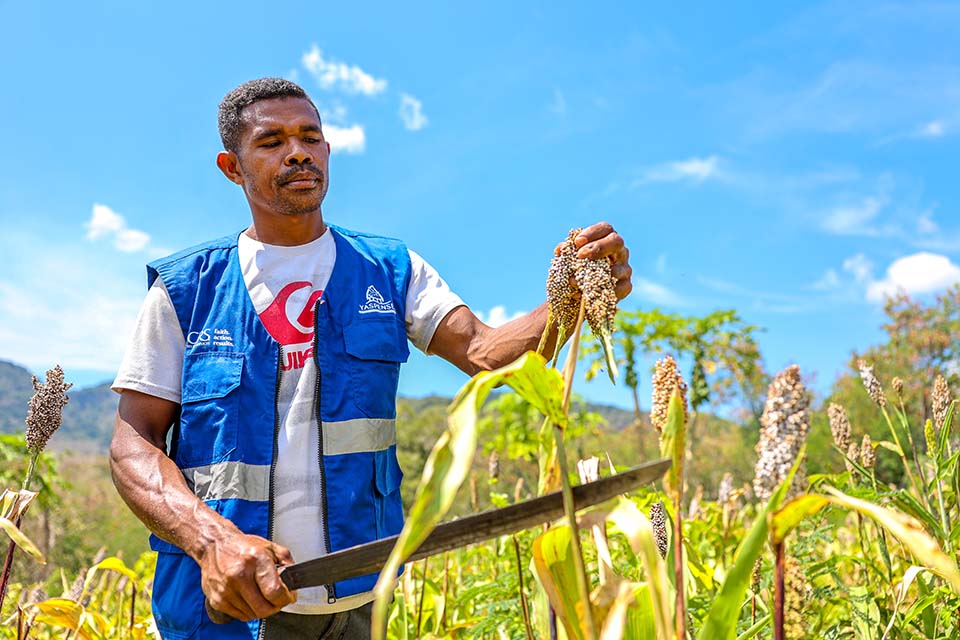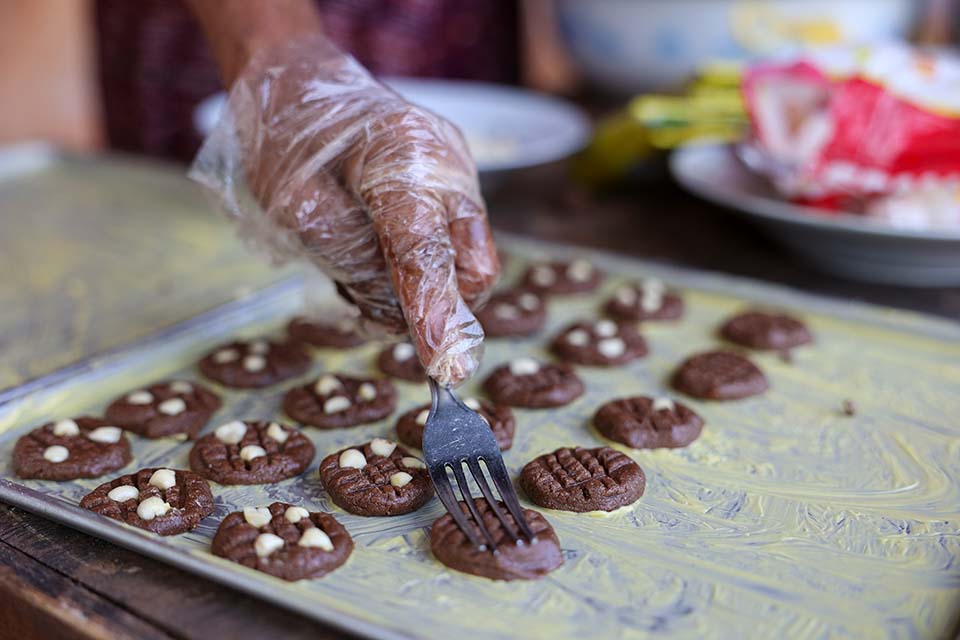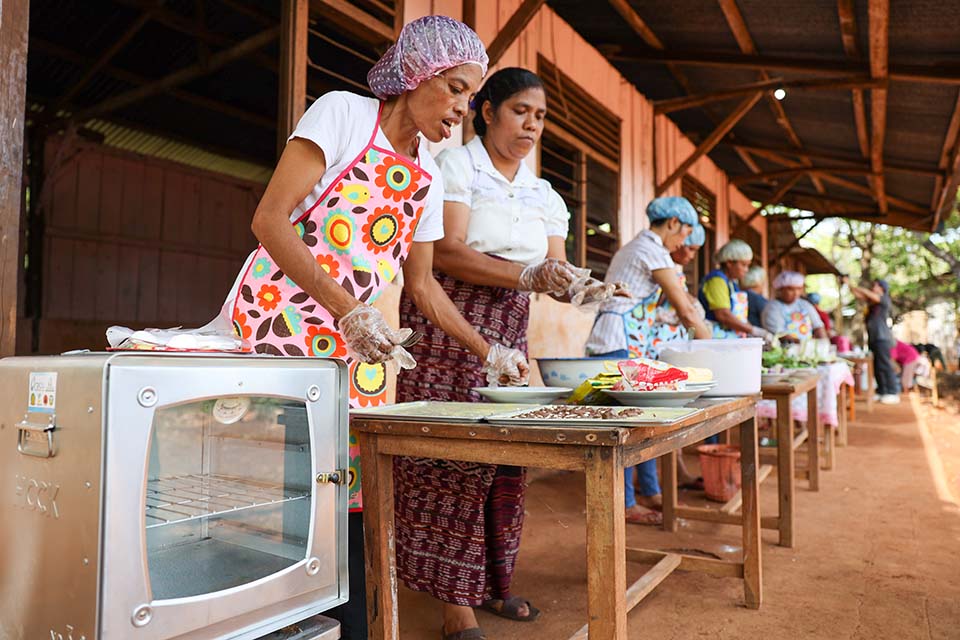

Sorghum Raises Health and Income in Indonesia
Under the beaming sun, Ancelmus Lio Wada, a farmer from Adabang village on Indonesia’s Flores Island, tends to his sorghum plot. It’s on an area the size of about four basketball courts—which when supplemented with fruit, vegetables and fish, is large enough to provide for Ancelmus’ family of five for approximately six months.

Ancelmus Lio Wada harvests sorghum, a crop that’s easy to plant and cultivate, and is also resilient to floods, drought and climate change. Sorghum is being promoted in East Flores district as a highly nutritious food crop that could help reduce stunting and malnutrition.
Photo by Benny Manser/CRS
Sorghum is rich in nutrients. It is easy to plant and cultivate, and it thrives on Flores Island. It’s also a great choice for farmers because it can withstand floods and droughts, both of which have become less predictable with a changing climate. As Indonesia is one of the world's most disaster-prone regions, this sturdy grain helps farmers reduce crop damage and loss. In some parts of Indonesia such as East Flores district, sorghum is being used to supplement rice and is a key ingredient in the government's programs to prevent stunting and malnutrition.
After three months of careful cultivation, Ancelmus inspects his sorghum plants to determine which are ripe for harvest. He avoids chemical pesticides and instead uses only natural fertilizers from animal dung.
“Sorghum is an important source of nutrition and food for my village,” Ancelmus says. “It is used to prevent malnourishment and stunting. It is also helping my seven-year-old nephew who has sorghum porridge. I can see he is healthy and able to concentrate more when studying.”
From planting to harvest, sorghum takes only about three months to grow. That quick turnaround means that Ancelmus has already harvested twice this growing season. His third harvest will be ready in the coming week. His neighbors are interested in growing their own sorghum, and Anclemus is ready to support them.
“During my second batch, harvest traders from another district came to buy, but I refused to sell. My communities’ needs are more important,” Ancelmus says. “I chose to distribute for free the harvest to be used by the community as seeds for their own sorghum plots. I also provided for free my own land for the community and already seven families have been growing.
“I think it’s important for the social welfare of the community for not only farmer groups, savings groups, disaster risk reduction groups, but for others too. I have the benefit of nutrition and health, and want others in the community to feel that too.”
The FLODESA* project has also promoted sorghum cultivation through nine demonstration plots in eight villages with a total of 175 farmers involved.
In Adabang village, two sorghum demonstration plots have been developed: one to cultivate seeds in collaboration with the District Government Agriculture Office, and another plot for food security of vulnerable families. A total of fifteen farmers—5 women and 10 men—have been developing the demonstration plots to show communities the potential of sorghum. A series of trainings and hands-on learning of sorghum cultivation, harvesting and processing is also helping the farmers improve food security and nutrition of the community.
New cookie ingredient

Catholic Relief Services provided baking tools including an oven, stove, sealer, mixer, pans, aprons, hairnets and gloves. The group’s newest product: sorghum cookies.
Photo by Benny Manser/CRS
Meanwhile, the smell of freshly baked cookies wafts through the air in Ancelmus’ village. Back at the Dasa Wisma kitchen, Katarina Peni Kilok takes hot cookies out of the oven. What makes these cookies unique is the unusual ingredient—sorghum—recently harvested from the village’s demonstration plot.
“Sorghum is easy to plant and grow in this area,” says Katarina. “We can get sorghum harvests and produce sorghum products, including cookies. The taste is different from other local ingredients such as cassava and banana. When testing sorghum cookies, the taste is much better. Some other crops have a long period of cultivation—six months—but for sorghum we can harvest in just three months.”
The cookies are not the only item on the menu. There is a vast array of food processing using sorghum including porridge, pudding, dumplings, dim sum and brownies.

Katarina Peni Kilok is part of “Dasa Wisma,” a group of 18 women who cook and bake together to earn money for their families. The women’s group has received training on making food with sorghum, product packaging and marketing, bringing a fresh income stream to their families.
Photo by Benny Manser/CRS
The FLODESA project has been promoting sorghum cultivation and providing training for community groups on processing local food made from sorghum. Katarina is part of Dasa Wisma, a group of 18 women who cook and bake together to earn money for their families. The women’s group has received training on food processing with sorghum, product packaging and marketing, bringing a fresh income stream to their families. The group enjoys a monthly income as a result.
Catholic Relief Services provided the group with baking tools, including an oven, stove, sealer, mixer, pans, aprons, hairnets and gloves. One of the group’s newest products are the sorghum cookies. For their first batch of cookies, the group prepared 100 packs for sale.
Training on food processing is helping communities become more resilient against emergencies and improve nutrition for the community.
* Flores Disaster Risk Reduction to Enhance Sustainable Livelihoods

